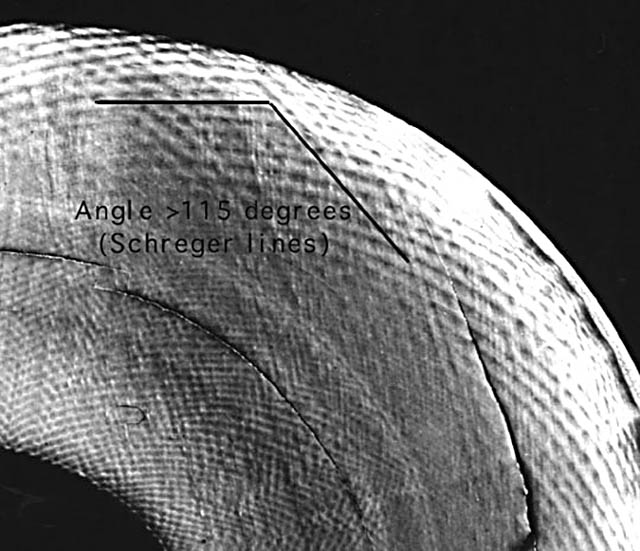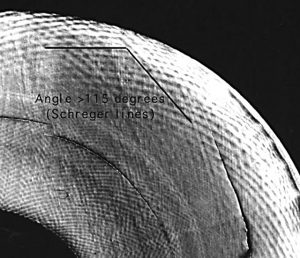

Distinguishing elephant from ancient ivory is challenging and becoming more and more important for the owners of knives with handles of ancient ivory. However, there are two reliable keys to make the determination easier.
Polished cross sections of elephant and mastodon/mammoth ivories display stacked chevrons of cross-hatched lines called Schreger lines or Lines of Retzius—incremental lines of rhythmic deposition of successive layers of enamel/dentine matrix during development. The Schreger lines closest to the outer bark of the tusks are the most visible—and the ones to measure—though there are also inner Schreger lines that are less discernible around the nerve cavity. The intersection of Schreger lines form angles, and this is the key—if the average angle is greater than 115 degrees, then it’s elephant ivory; if the average angle is less than 90 degrees, it’s mastodon or mammoth. Variations in the angles can occur in individual tusks, particularly as the patterns tighten more toward the center. Plus, the visible cross section must be cut square to the axis of the tusk—otherwise the chevrons’ angles will be distorted.
Specimens from both extinct and existing animals can show angles between 90 and 115 degrees in the outer Schreger lines, so the differentiation should never be based solely on a single angle measurement when the angles fall in this range. When averages are used, a clear separation between the ivory of existing elephants and extinct mammoths/mastodons exists. Elephant ivory averages above 100 degrees and mammoth/mastodon ivory averages below 100 degrees.
Another I.D. key, though more involved, can also distinguish mammoth or mastodon ivory from elephant. These ancient ivories can often have blue-green or brownish blemishes on the surface produced by an oxidized iron phosphate called vivianite. Even if the discoloration is barely visible, ultra-violet light will make it stand out with a dramatic velvety-purple appearance. Even if elephant ivory were similarly discolored—though in its natural state, elephant ivory will not display the same discoloration—it would not exhibit the characteristic fluoresence of vivianite.
With recent ivory laws handed down by Fish and Wildlife greying the lines between elephant and ancient ivories, it is possible the laws may give federal agents the right to seize knives and materials that cannot be proven as outright ivory but simply have the ivory look. As a result, if you own knives with ancient ivory handles, having an at least a general knowledge of how to differentiate elephant from ancient ivory could save you from having your knives confiscated, from being fined or both.
Hot Knife Deals at ShopBlade.com
 NEXT STEP: Download Your Free KNIFE GUIDE Issue of BLADE Magazine
NEXT STEP: Download Your Free KNIFE GUIDE Issue of BLADE Magazine
BLADE’s annual Knife Guide Issue features the newest knives and sharpeners, plus knife and axe reviews, knife sheaths, kit knives and a Knife Industry Directory.Get your FREE digital PDF instant download of the annual Knife Guide. No, really! We will email it to you right now when you subscribe to the BLADE email newsletter.








The “test” describes the differance between mammoth and ivory. Presently it is not possible to judge/test the age of ivory with any simple test!
For further information, please google “International Ivory Society. This orginization has been very active in fighting ivory bans. Knives, instruments, culture items, netuske, and other antiques should be permitted to be bought and sold freely.
The idea of saving elephants is a mixed issue. There are growing herds in Africa. The (decreasing) free land can not support such numbers. Should the American government be involved with conservation efforts in foreign countries? What differance has it made in the past 15 years?
Yes, that is all the story addresses, how to tell the difference between ancient and elephant ivory. Nothing is mentioned in the story about testing the age of the ivory. Another good source of information on the ivory situation is the Elephant Protection Association. Visit it at elephantprotection.org. They have some views concerning growing elephant herds in Africa, the federal government’s involvement in the elephant ivory situation and other matters you should find interesting.
Hi Steve,
Excellent article, but where does walrus ivory fit in and how does it differ from elephant ivory? I have some ivory scales that a client gave me that he claimed was walrus. I don’t know the science and how to tell the difference between walrus and elephant ivory. Thanks. Rick
Good question, Rick. I don’t know–but i bet the man who wrote the story that i gleaned the info from would–knifemaker Jim Hammond. Contact him at jim@jimhammondknives.com. If he doesn’t know the answer, i bet he knows who will.